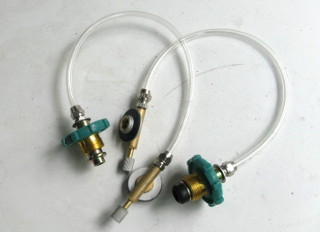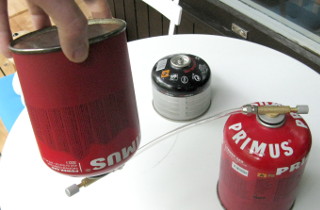<HOME
How to combine the leftover gas in Primus cylinders
Risky business! Don't do this!
When hiking alone in Lapland, I mostly use my
wood-burning titanium campstove for cooking. But for shorter hikes,
or when cooking for two, the Trangia campstove is much more
convenient. I have both spirit and gas burners for mine, and I really
like the convenience of gas! Also its energy
density is higher, per weight, than spirit. But it has, however, one
major drawback: how to combine
leftovers? Leftover spirit is easily poured from one bottle to another,
but after a couple of hikes I find myself with several partly used gas
cylinders lying around. There's not much point in taking an almost empty
cylinder on a hike of any significant length, and the almost-empties are
not easily combined! And the energy density advantage of gas over spirit
is quickly lost, if the relatively heavy steel cylinder isn't completely
full of fuel to begin with.
So I set about finding a way to combine those leftovers into a single
cylinder.

|
Ebay has a variety of adapters available to refill small camping gas
cylinders from the large LPG cylinders used for barbecues etc.
Refilling
camping gas cylinders that way has its risks, for example the pressure of
pure propane can be much higher than that of the butane/isobutane/propane mix
commonly used in the camping cylinders. But cheaper refills were not my main
incentive anyway—I just wanted to make use of the leftovers of
authentic camping gas mix, by combining the contents of two (or more)
cylinders into one.
So I ordered two refill adapters ("outdoor propane refill
adapter" are suitable search keywords), and mutilated them to
make my own.
Both refill adapters have one end that fits a big LPG tank, and
the other end that fits the threaded Primus cylinder (it is called a
Lindal B188 valve, which is a 7/16" UNEF threaded
valve used on EN 417 stoves) and the fitting has a
needle valve on it. The
fittings are connected via a short length of plastic high-pressure hose
(see below). I ordered two such adapters. One was already missing a gasket
at the LPG tank end! That's ebay for you. But the Lindal valves were all
that I wanted, and they were ok, so no big deal.
|

|
The hose is marked "PU TUBE 6MMX4MM", which probably
means polyurethane with 6 mm outer and 4 mm inner diameter. I
found a smiliar hose on Amazon, rated for some 12 bar pressure, which
ought to be safe enough for this use. (Pure propane, with its
10 bar vapor pressure at room temperature, might be cutting it
close knowing the quality you sometimes get from cheap ebay goods. But
for butane/isobutane/propane camping mix it should be plenty—the
vapor pressure of butane is about one fifth that of propane.)
I cut off the LPG tank end from one adapter. Then I
disassembled the Lindal valve from the other adapter, which entailed
simply removing the locking nut and pulling off the hose. Now I could
assemble my own Lindal valve to Lindal valve adapter.
|

|
This modified adapter now has a Lindal valve fitting, with a needle valve,
at both ends. Now I can use this adapter to connect two camping gas
cylinders together in order to to transfer leftover gas from one cylinder
into another.
|
As both the giving and receiving cylinders are under significant and
possibly differing pressure, you can't assume gravity to do all the hard
work. Rather, you need to lower the pressure of the receiving cylinder
compared to the giving one. Elementary physics tells us you can do this by
cooling down the receiving cylinder in the fridge,
since the equilibrium pressure of a
liquid/gas system depends solely on the temperature. Now the gas will happily
flow in the direction you intended (from the warm cylinder into the cold one),
until the temperatures equalize.
You could simply let gas flow between the cylinders: the liquid will
boil off from the warm cylinder and condense back to liquid in the cold
cylinder, but this will also pump heat from the warm cylinder into the
cold one, causing the temperatures to equalize fast. So you will be
better off turning the giving cylinder upside down. That way, liquid
will be transferred instead of gas, and there will be less boiling and
condensing going on, resulting in less heat transfer. You should be able
to transfer at least some 100 g of fuel in one go, without having
to cool down the receiving cylinder again. When combining two half-spent
cylinders I did need to cool the receiving cylinder twice, as the flow
came to a halt on the first go. You could also use a freezer to cool the
receiving cylinder down even further, but please don't try to heat the
giving cylinder in an oven...
When combining leftovers, be careful not to overfill the cylinder. You've
noticed that a fresh cylinder straight from the store is not 100% filled
with liquid, but rather it sloshes when shaken. Don't fill the
receiving cylinder any further than that! A kitchen scale can be
used to check the fill level, if you have a similar unused cylinder on an
empty one as reference. The tare weight of an empty 450 g (net)
Primus cylinder is around 220 g, but that may vary across brands.
Also, since
the valves on the cylinders won't last forever, but may eventually wear out
and start to leak, I make it a point not to re-use a cylinder more than once.
To that end, I always label a topped-up cylinder "leftovers" and
never top it up again.

|
Here's the procedure I follow. I do not recommend that you do this,
because it is intentional misuse of this kind of
gas cylinders, which are not
designed to be re-fillable. I say again, do
*not* try this at home!
- Put the receiving cylinder in the fridge to cool it down. Leave the
giving cylinder at room temperature.
- Close both valves in the adapter. Attach the giving cylinder, and
flush the hose by briefly opening both valves. Close the valve at
the unconnected end.
- Attach the cold receiving cylinder. With the giving cylinder
upside down, open both valves and allow the fuel to flow.
- When finished, close both valves and disconnect both cylinders. Then
open both valves to vent the hose.
|
I say once more, do not try this yourself! If you do, you will
explode your gas cylinders, destroy your home, kill your cat and
cause civil unrest in your neighborhood! Your hiking hobby is
tolerable, but bombmaking goes too far. But if you are determined to
make a mess, I take no responsibility for what happens.
Which is better, gas or spirits?
So gas is more convenient for cooking, good for you! But what if
you just want to minimize weight? A plastic 1-liter bottle of spirit
weighs some 864 g, of which some 790 g or 91% is actual fuel.
Whereas a 450 g (net) gas cylinder weighs some 673 g in
total—only about 67% of that weight is actual fuel you can burn!
All the rest comes from the relatively heavy steel cylinder required to
handle the pressure of the liquefied gas—is it really worth carrying
that extra weight around with you?
I looked up some enthalpies of combustion from the all-knowing CRC
Handbook of Chemistry and Physics [1]. The
values, corrected for the vaporization of
water [2], and calculated in terms of fuel
weight, are shown in the table below. To give some perspective, it takes
420 kJ (plus all heat losses [3]) to heat
up a liter of water from 0°C to 100°C.
| Chemical | Enthalpy of combustion |
| Ethanol | 27.02 kJ/g |
| Isopropanol | 30.66 kJ/g |
| Propane | 46.64 kJ/g |
| Isobutane | 46.33 kJ/g |
Denatured spirit may contain various amounts of isopropanol or other
alcohols, and trace amounts of ketones and other crap. As you can see
from the table, isopropanol and ethanol are pretty similar in terms of
their enthalpy of combustion, so I'll just use the value for pure
ethanol. And in fact, this value will be rather optimistic, since
azeotropic ethanol contains 4.4% of water—that water not only
does not burn, but in fact consumes some heat as it needs to be
evaporated. The correct value for pure azeotropic ethanol would be some
25.73 kJ/g, but if there's much isopropanol in the mixture, that
figure will improve a bit. Not much, though.
Typical camping gas is a mixture of propane and isobutane, but as you
can see from the table, the hydrocarbons are extremely close in
their enthalpies of combustion, so I'll just use the value for pure
propane.
Now it is easy to calculate, that a full 1-liter flask of spirit, with a
net weight of 790 g, contains less than 21.35 MJ (due to
the water issue I mentioned above), which comes out to a maximum of
24.71 kJ/g when calculated per gross weight of 864 g.
The 450 g gas cylinder, on the other hand, contains 20.99 MJ,
which comes out to 30.98 kJ/g for a gross weight of 673 g.
So there you have it. Cylinders of camping gas win by a narrow margin,
assuming they are full! But as you can see, it will not take much
use of a gas cylinder to put it below spirits in its gross energy density. (Which
is why I built the refill adapter described above.) But also, as you
consume fuel, your backpack loses that much weight, but the tare weight of
the cylinder does not go away in the same proportion. So if you were to
average the weight you carry over the entire length of your hike, spirit
would certainly win. Gas would only win when initial weights
are criticized.
Which is one reason why I don't choose camping gas for my fuel when hiking
alone and need to minimize weight. But mainly it's because
my ultralight
wood-burning titanium campstove will easily accommodate a spirit
burner, but not the standard Trangia gas burner. And I do not lug
the entire heavy Trangia with me when alone! One alternative would be a
small burner which screws directly onto the cylinder, but I've been happy
enough with the spirit burner—mostly I use wood for fuel anyway! However, if
I do lug the 1.4 kg Trangia, then there's not much sense not to
choose gas, just to optimize on a few hundred grams of tare weight.
[1] D. R. Lide (editor),
CRC Handbook of Chemistry and Physics, CRC Press, Boca Raton, 76th
edition, 1995.
[2] The standard values are given
for a reaction where the products CO2 and H2O are
in gaseous and liquid form, correspondingly. Unless all the produced water
condenses on the pot, that figure will be slightly too high. So, for ethanol
as an example, the reaction being
C2H5OH + 3 O2 → 2 CO2 + 3 H2O,
three times the molar enthalpy of vaporization of water must be subtracted
from the enthalpy of combustion for a realistic figure.
[3] I tested how much spirit my
campstove consumes to heat up 1.5 liters of water in a pakki.
From 10°C to 100°C took 44 grams, which is about 1130 kJ.
For 1 liter from 0°C to 100°C that comes to 840 kJ, so
the efficiency was just about 50%, the other 50% went to losses! That's
quite bad, actually. I'll have to test the Trangia the same way,
I expect it will be quite a bit more efficient.
Antti J. Niskanen <uuki@iki.fi>



